This publication discusses some of the least-toxic control options you can use for pests of houseplants, home greenhouses and interior plantscapes. Many of these tactics are recommended for homeowners who want to manage pests without using broad-spectrum synthetic pesticides. For more detailed information, please refer to the references at the end of this publication.
Spider mites
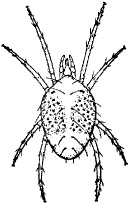 Spider mites, or red-spiders, appear as tiny dots moving over the plant surface. They have fine piercing/sucking mouthparts and feed by sucking out plant fluids. Their feeding activity on plant tissue results in a browning of the foliage ("bronzing") due to the loss of chlorophyll. You can see silken webbing over parts of the plant when populations are high. Hot, dry weather favors rapid spider mite development, whereas low temperature, high humidity and excess moisture are unfavorable.
Spider mites, or red-spiders, appear as tiny dots moving over the plant surface. They have fine piercing/sucking mouthparts and feed by sucking out plant fluids. Their feeding activity on plant tissue results in a browning of the foliage ("bronzing") due to the loss of chlorophyll. You can see silken webbing over parts of the plant when populations are high. Hot, dry weather favors rapid spider mite development, whereas low temperature, high humidity and excess moisture are unfavorable.
Hosts
A commonly encountered spider mite is the twospotted spider mite. It attacks a wide variety of field, garden, greenhouse, nursery and ornamental plants as well as several weed species. It can be found on all areas of the plant.
Control options
Chemical
- Apply an insecticidal soap.
- Apply a 2 percent solution of horticultural oil.
- Sulfur sprays and dusts can be helpful (greenhouse only).
Biological
- Various predatory mite species (e.g., Phytoseiulus persimilis, Amblyseius californicus) are available commercially for release on mite-infested plants in the home and greenhouse. They cannot bite people, and they do not leave the plants.
Mechanical
- Wash plants with soapy water (2 teaspoons mild detergent per gallon of water) and a soft brush, making sure to wash the undersides of leaves.
- Hosing tough plants with a forceful spray of water knocks off mites and destroys their webs.
Cultural
- Mist plant foliage periodically to increase humidity around the plant, and avoid high temperatures and soil-moisture stress.
- Quarantine new plants and treat before placing them among established plants.
- Consider carefully if plant species particularly susceptible to spider mite infestations are worth their keep.
Aphids
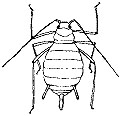 Aphids are small (1 mm to 6 mm), soft-bodied and pear-shaped. Individuals may or may not be winged; antennae and legs are fairly long. Aphids feeding on plant sap cause leaves to become curled and crinkled. They also excrete a sticky substance called honeydew that may completely coat the foliage. Honeydew attracts ants and is a substrate for black sooty molds.
Aphids are small (1 mm to 6 mm), soft-bodied and pear-shaped. Individuals may or may not be winged; antennae and legs are fairly long. Aphids feeding on plant sap cause leaves to become curled and crinkled. They also excrete a sticky substance called honeydew that may completely coat the foliage. Honeydew attracts ants and is a substrate for black sooty molds.
Hosts
Aphids infest nearly all types of indoor, greenhouse, garden and ornamental plants. Colonies are most commonly found on the shoots of new growth, but also may appear under leaves, on stems or on bulbs and roots.
Control options
Chemical
- Apply an insecticidal soap.
- Use the botanical insecticides pyrethrins or neem.
Biological
- Three aphid predators available commercially are the green lacewing, convergent lady beetle and the aphid-eating gall midge. These predators can substantially help control aphids on greenhouseplants.
Mechanical
- Wash plants with soapy water (2 teaspoons mild detergent per gallon of water) and a soft brush, making sure to wash the undersides of leaves.
- Screening greenhouse vents, windows and doors helps prevent aphids from entering the greenhouse from the outside and helps prevent the escape of released beneficial organisms.
- Prune or pinch off heavily infested plant parts.
- During warm weather, take infested plants outside and hose them off with a stream of water.
- Control small populations of aphids by squashing the soft-bodied insects with your fingers.
Note
Only prune or wash off plants if no predators or parasitoids have been released in the greenhouse.
Cultural
- Use slow-release fertilizers with moderate proportions of nitrogen. Aphids, like mealybugs and scale, thrive on plants with overly succulent growth (often due to high nitrogen levels). Do not overfertilize.
- Quarantine new plants and treat before placing them among established plants.
Thrips
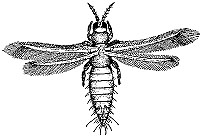 Thrips feed by rasping on the plant surface and drinking up the fluid. This feeding activity results in brownish streaks (feeding scars) on light-colored foliage or petals and white or silvery streaks on dark-colored foliage. They can be found on the leaves, blossoms, buds and leaf sheaths of plants. Thrips leave tiny black drops of excrement in the feeding areas. Thrips also are vectors for certain plant diseases.
Thrips feed by rasping on the plant surface and drinking up the fluid. This feeding activity results in brownish streaks (feeding scars) on light-colored foliage or petals and white or silvery streaks on dark-colored foliage. They can be found on the leaves, blossoms, buds and leaf sheaths of plants. Thrips leave tiny black drops of excrement in the feeding areas. Thrips also are vectors for certain plant diseases.
Hosts
Thrips attack the foliage, buds and flowers of many vegetable, ornamental and flowering plants.
Control options
Chemical
- Apply an insecticidal soap.
- Use the botanical insecticides azadirachtin or pyrethrins.
Biological
- Thrips have several natural enemies that are available commercially: predatory mites (Amblyseius mackenziei, A. cucumeris), lacewings, damsel bugs and pirate bugs. The latter three predators commonly are found in the garden during the summer and can be captured relatively easily and brought indoors for thrips control in small greenhouses and sun porches.
Mechanical
- Use blue sticky cards, either hung just above greenhouseplants or placed on stakes in the plant pots, to detect thrips and help reduce their numbers.
- Use a forceful spray of water to reduce numbers of thrips on sturdy plants.
Cultural
- Mist plants frequently. High humidity is detrimental to many thrips species. Periodically flood earthen greenhouse floors to drown pupating thrips.
- Soils high in organic matter seem to favor those thrips that pupate in the soil.
- Quarantine new plants and treat before placing them among established plants.
Scale
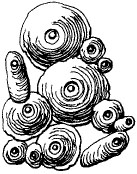 Scale insects are among the most destructive plant-feeding insects. Heavily infested plants often are covered with small, disklike or waxy coverings, and underneath each covering is the scale organism feeding on the juices of the plant. Two types of scale attack indoor plants: soft scales and armored scales. Soft scales produce honeydew, and armored scales do not. Feeding activity results in the distorting, stunting and yellowing of foliage.
Scale insects are among the most destructive plant-feeding insects. Heavily infested plants often are covered with small, disklike or waxy coverings, and underneath each covering is the scale organism feeding on the juices of the plant. Two types of scale attack indoor plants: soft scales and armored scales. Soft scales produce honeydew, and armored scales do not. Feeding activity results in the distorting, stunting and yellowing of foliage.
Hosts
Scale insects are common pests of many indoor, greenhouse and ornamental plants as well as many trees and shrubs. They typically are found on the undersides of leaves and stems.
Control options
Chemical
- Apply an insecticidal soap.
- Apply a 2 percent solution of horticultural oil.
Biological
- Beneficial parasitic wasps and predators (e.g., lacewings and lady beetles) that control scale in greenhouses are available from commercial sources.
Mechanical
- Scales can be rubbed off plants by hand using garden gloves, a toothbrush or a dry or alcohol-dipped cotton swab. However, this treatment may not be adequate when scale are present in large numbers.
- Wash plants with soapy water (2 teaspoons mild detergent per gallon of water) and a soft brush, making sure to wash the infested parts.
- Prune heavily infested plant parts.
Cultural
- Mist frequently to dislodge crawlers (newly hatched scale).
- Use slow-release fertilizers with moderate proportions of nitrogen. Scale, like mealybugs and aphids, thrive on plants with overly succulent growth (often due to high nitrogen levels). Do not overfertilize.
- Quarantine new plants and treat before placing them among established plants.
- Discard heavily infested plants.
Mealybugs
 Mealybugs are slow-moving insects that are covered with a white, waxy substance. Intense feeding activity results in loss of color, wilting and death of the affected plant part. Mealybugs also produce large amounts of honeydew that coats the foliage and serves as a substrate for black sooty molds.
Mealybugs are slow-moving insects that are covered with a white, waxy substance. Intense feeding activity results in loss of color, wilting and death of the affected plant part. Mealybugs also produce large amounts of honeydew that coats the foliage and serves as a substrate for black sooty molds.
Hosts
Mealybugs occur on several species of garden, house and greenhouseplants. They usually are found in clusters along the veins on the undersides of leaves and in crevices at the base of leaf stems.
Control options
Chemical
- A few mealybugs found on a plant can be killed by dabbing the visible insects with alcohol on a cotton swab (alcohol dissolves the wax around the insect and its egg masses and kills them). This strategy is not adequate when mealybugs are present in large numbers.
- Use an insecticidal soap.
- Apply a 2 percent solution of horticultural oil.
- Use a botanical insecticide of pyrethrins and rotenone.
Biological
- Commercially available natural enemies of mealybugs include mealybug destroyers (a type of lady beetle), green lacewings and the parasitoid Leptomastix dactylopii.
Mechanical
- Wash plants with soapy water (2 teaspoons mild detergent per gallon of water) and a soft cloth.
- When plants are lightly infested, kill mealybugs by rubbing them off with your fingers.
- Where the plants are few and the mealybug infestation is light, prune out the infestation.
- Dislodge mealybugs by hosing down plants frequently unless biological control agents are present, in which case mist to remove honeydew accumulations.
Cultural
- Quarantine new plants and treat before placing them among established plants. Spot treat with insecticidal soap if needed.
- Use slow-release fertilizers with moderate proportions of nitrogen. Mealybugs, like scale and aphids, thrive on plants with overly succulent growth (often due to high nitrogen levels). Do not overfertilize.
Fungus gnats
 Fungus gnats are tiny, dark, fragile-looking insects. Most of the time they are a nuisance pest. When laying eggs, females are attracted to moist soils or areas of high organic matter. In containers, larvae primarily feed on the organic matter but also will attack the roots and root hairs of young plants. Heavy fungus gnat infestations result in the wilting and eventual death of affected plants.
Fungus gnats are tiny, dark, fragile-looking insects. Most of the time they are a nuisance pest. When laying eggs, females are attracted to moist soils or areas of high organic matter. In containers, larvae primarily feed on the organic matter but also will attack the roots and root hairs of young plants. Heavy fungus gnat infestations result in the wilting and eventual death of affected plants.
Hosts
Numerous greenhouse and houseplants are susceptible to fungus gnats. All bedding plants and vegetables grown in plugs are vulnerable. The fungus gnat also is a primary pest of mushroom houses.
Control options
Chemical
- House-plant sprays containing pyrethrins or pyrethroids (e.g., resmethrin) help control adult fungus gnats. Because the adult flies live only a few days and new adults emerge daily, you need to use these sprays every few days for at least two weeks before populations are reduced.
Cultural
- Sanitation. Keep areas in the greenhouse free of weeds and organic matter and dry under benches.
- Allow soil to dry thoroughly between waterings, and tailor watering to plant-growth needs to prevent unnecessary soil-fungus growth.
- Remove and discard growing media, and repot in sterile media.
- Fungus gnats are attracted to wheat sprouts. Place a pot of sprouted wheat among the plants you want to protect. Allow female gnats a few days to lay their eggs on the wheat sprouts, then remove the pot and discard its contents outdoors. Repeat this procedure every two weeks until the flies are no longer a problem.
Biological
- In greenhouses, fungus gnat larvae can be controlled with a bacterial soil drench of a certain type of Bt (Bacillus thuringiensis), of which some trade names include Gnatrol and Knock-Out Gnats.
- Beneficial nematodes (Steinernema sp.) may be released into the soil to control larvae.
Leafminers
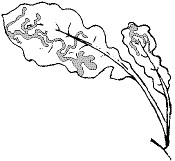 As leafminers feed within leaves and stems, they form tunnels or "mines." After feeding, they leave the plant and pupate in the soil. Extensive feeding renders the foliage unsightly. In heavy infestations, the leaves can drop. The most common type of leafminer on indoor plants is the maggot of agromyzid flies in the genus Liriomyza.
As leafminers feed within leaves and stems, they form tunnels or "mines." After feeding, they leave the plant and pupate in the soil. Extensive feeding renders the foliage unsightly. In heavy infestations, the leaves can drop. The most common type of leafminer on indoor plants is the maggot of agromyzid flies in the genus Liriomyza.
Hosts
Numerous ornamental plants (e.g., chrysanthemums, asters, marigolds) and vegetable plants (e.g., tomato, cucumber, pepper, lettuce) are susceptible to attack by Liriomyza leafminers.
Control options
Chemical
- Apply a 2-percent solution of horticultural oil; it has a repellent action against adult feeding and egg laying.
- Use the botanical insecticides rotenone or neem.
Mechanical
- Where the plants are few and the leafminer infestation light, pick infested leaves off by hand.
- Yellow sticky cards placed just above plants can detect the presence of adult leafminers and help reduce their numbers.
- In a greenhouse setting, cover the soil with a plastic mulch. This prevents the larvae from reaching the soil to pupate.
- Spade the ground thoroughly about the base of plants to destroy pupae.
Cultural
- Avoid cultivars susceptible to leafminer attack.
Whiteflies
For information on controlling whiteflies by alternative and conventional methods see MU publication G7275, Managing Whiteflies on Indoor and Outdoor Plants.
Read labels carefully
Before using any chemical, please read the label carefully for directions on application procedures, appropriate rate, first aid and storage and disposal. Make sure that the chemical is properly registered for use on the intended plant and pest.
Check for phytotoxicity warnings
Certain chemicals, including oils and insecticidal soaps, may cause plant injury if used at the wrong stage of plant development or when temperatures are too high. Injury also may result from excessive amounts or the wrong formulation or from mixing incompatible materials. Please read the label carefully for phytotoxicity warnings.
References
- Common-Sense Pest Control, by W. Olkowski, S. Daar and H. Olkowski, The Taunton Press, Newtown, CT, 1991; ISBN 0-942391-63-2
- Pests of the West, by Whitney Cranshaw, Fulcrum Publishing, Golden, CO, 1992; ISBN 1-55591-097-1
- The Encyclopedia of Natural Insect and Disease Control, edited by Roger Yepsen, Rodale Press, Emmaus, PA
1984; ISBN 0-87857-488-3